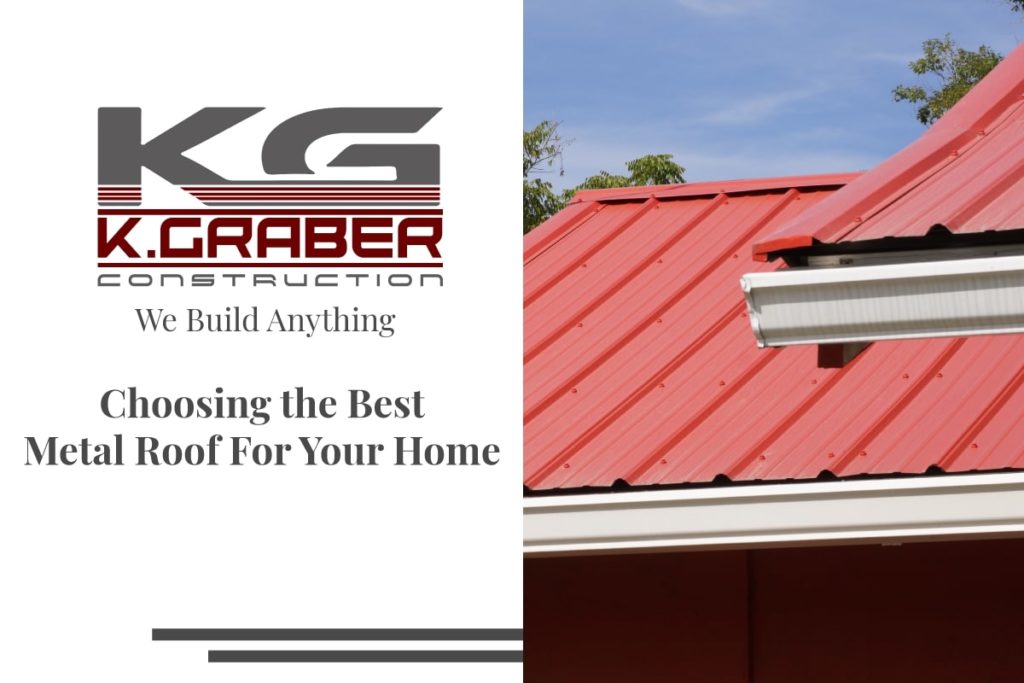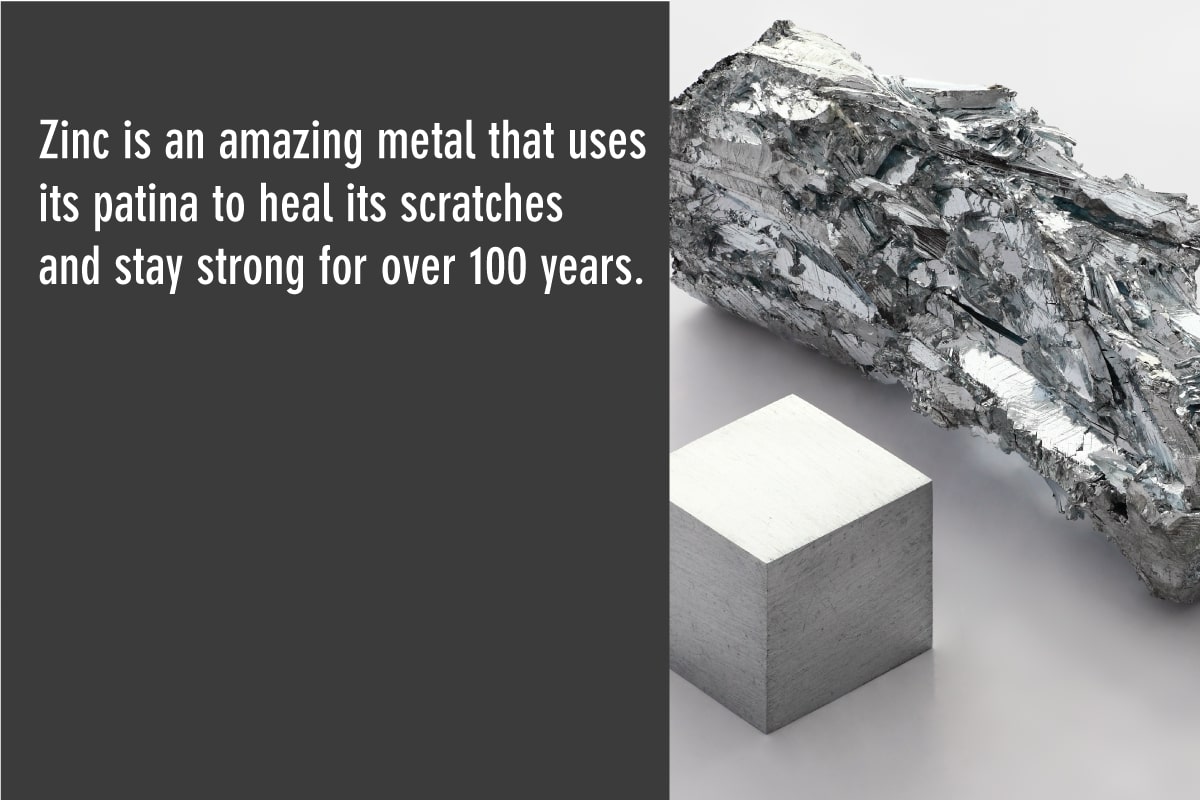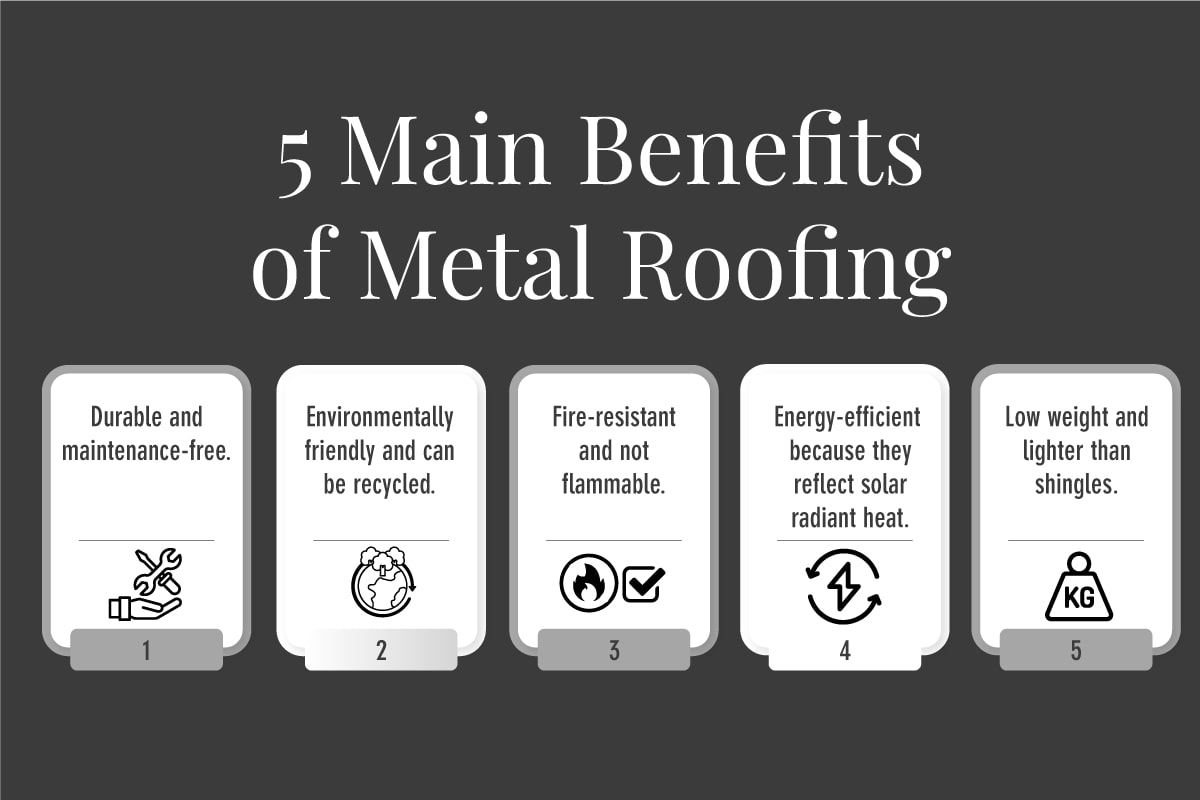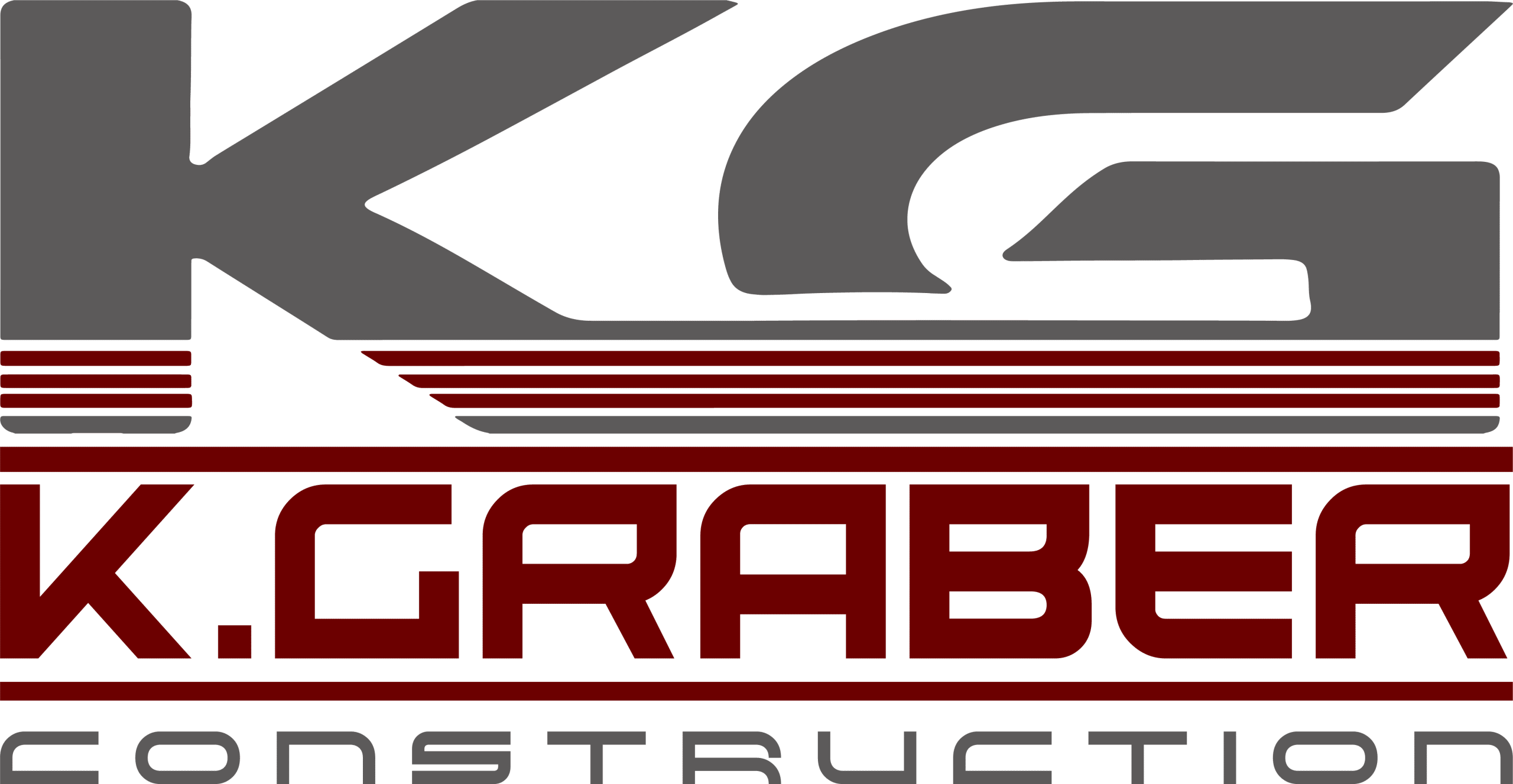
Choosing The Best Metal Roof For Your Home Or Business – Everything You Need To Know
Are you ready to replace the asphalt shingles on your roof?
Maybe you’ve heard that metal is a good roofing material, but you're unsure if it's right for you. You don’t want to blunder into a misinformed decision and spend years regretting a mistake.
Don’t worry, we get it!
At K. Graber Construction, we want to help you understand the ins and outs of metal roofing so you can make an informed decision about the roofing material that’s best for you.
We’ll explore different kinds and styles of metal roofs, as well as explore how metal roofs compare to other roof types, so you can get a big-picture view of what’s at stake.
Let’s get started!
4 Main Types Of Metal Roofing
The term "metal roofing" doesn’t describe a specific product, but rather an entire range of products.
When you say, “I want a metal roof,” you aren’t limiting yourself to one kind of roof. You are opening up a world of opportunity!
After all, there’s more than one kind of metal.
Let’s take a look at each of the popular materials used to create metal roofs and the pros and cons of each.
Copper Roofing
Copper roofing has been used all over the world for centuries. Copper is an extremely durable metal, and in ideal environments, lasts well over 200 years.
In fact, you may recognize some famous historical structures that have copper roofs.
Belvedere Palace in Vienna, Austria, and Berlin Cathedral Church in Berlin, Germany, are both exquisite buildings that display copper roofs.
But if you look at these roofs, you’ll notice that they have a beautiful green color instead of the shiny, bronze color normally associated with copper.
Why does copper change color?
Copper naturally turns green over time as it reacts with oxygen in the air—a chemical reaction known as oxidation.

The green color is simply the natural shade of the patina that forms over the copper surface. The patina protects the copper from deterioration and creates a gorgeous bluish-green color, which is seen on many copper rooftops and structures.
This green patina protects copper, making it one of the most long-lasting roofing materials.
Copper has a few downsides, though.
For one, it’s a soft metal, which means it is easily dented by debris and hail. Copper also expands and contracts with extreme temperatures, which can cause maintenance issues.
While undoubtedly beautiful, copper is more expensive than most roofing materials. Depending on your needs, it may not give you the most bang for your buck.

Aluminum Roofing
Aluminum roofing is popular due to its ability to resist corrosion.
When the outer layer of aluminum reacts with oxygen, it creates a layer of aluminum oxide that protects the inner layers of metal from corrosion.
This ability to resist corrosion makes aluminum a great choice of roofing material in coastal areas. However, aluminum's natural patina is not considered aesthetically pleasing, so it is usually painted.
Like copper, the big downside of aluminum is its cost. The price of aluminum fluctuates depending on the market, typically falling somewhere between steel and copper.
Because of its price, aluminum roofing panels are thinner than steel panels. That means aluminum roofing may not work well if you live in a region with high winds, hail, or severe inclement weather.
If you want the anti-corrosive properties of aluminum but need something a little sturdier, you might consider installing a steel roof and then applying an aluminum roof coating.

Zinc Roofing
Zinc is an excellent metal that uses its patina to heal scratches and stay strong for over 100 years.
Zinc is considered a “green” metal since the energy required for processing zinc is so low.
Zinc is also 100% recyclable and available in most local markets.
However, zinc has two main downsides.
First, zinc is not particularly aesthetically pleasing. Like most bare metals, zinc forms its own natural patina. This patina is a bluish, gray color.
It’s not the patina itself that’s problematic, though.
When water flows on chalk roofs, a little residue remains. This chalking effect doesn’t look good.
Second, zinc is not cheap. In fact, like copper, zinc is one of the most expensive roofing materials.

Steel Roofing
When you think of a metal roof, you most likely think of a steel roof.
Why?
Because steel is the most commonly used roofing metal.
Steel is an alloy made from iron and other elements. It is very sturdy and quite resistant to inclement weather. On average, a steel roof lasts at least 50-70 years.
Like zinc, steel is also considered a green material since it can be recycled. It's also less expensive than other metals. This makes steel both affordable and available in more significant quantities.
Steel, as an alloy, does not create a natural patina. That means steel is susceptible to rusting. However, steel lasts years without rusting when painted and coated with a PVDF roof coating.
If you're interested in steel roofing, here are the three sub-types of steel you'll most likely choose from.
- Galvanized Steel is created using a zinc layer to protect an inner layer of steel from corrosion. This is the most common form of steel roofing material.
- Galvalume Steel is similar to galvanized steel, but rather than using only zinc for its protective coating, it uses a combination of aluminum and zinc. This offers better surface protection than galvanized steel.
- Weathering Steel is heavy steel designed for demanding industries like bridge construction. It is designed to rust intentionally, protecting the inner layer of steel. Weathering steel is often used in accent roofs with the understanding that regular maintenance will be needed.

Main Styles Of Metal Roofing
Once you’ve chosen a metal for your new roof, you’ll need to select a style of roof. While the style options for metal roofing are endless, breaking them down into three main categories is helpful.
-
Standing seam metal roofing (hidden fastener)
-
Corrugated metal roofing (exposed fastener)
-
Interlocking modular metal panel roofing
Standing Seam Metal Roofing
Every roof has to be fastened to the roof deck in one way or another. Asphalt shingles, for example, are nailed to the roof deck.
Metal roofs are screwed to the roof deck instead of nailed to the roof deck. However, two significant differences exist in how metal roofs are screwed to the roof deck.
Pros of Standing Seam Metal
Hidden fastener metal roofing, typically called standing seam metal roofing, snaps together and hides the fastening system from view.
Since all the fasteners are hidden beneath the metal roof, they are unlikely to leak.
That’s a big deal!
After all, a leaking roof isn’t doing its job.
Because standing seam roofing is so watertight, it can be used on lower roof pitches than other metal roofing styles. While most metal roofing styles can’t be used on a roof pitch under 3/12, standing seam can be used down to 1/12.
And there’s much more to like about standing seam metal than just the fastening system!

Standing seam roofing is considered premium metal roofing. It is usually made from thicker metal and finished with the best PVDF paint system.
Standing seam metal is also custom-made for your project. Contractors that install standing seam roofs have a machine that takes large rolls of metal and bends the metal into a snap-lock system. It also fabricates the metal sheets to the exact length needed for your project.
Standing seam roofing also works with all types of roofing metal, including copper, zinc, aluminum, and steel!
Another perk of standing seam roofs is that the fastener system allows the metal to expand vertically.
Why is this a big deal?
Other styles of metal roofing that fasten directly to the roof deck do not have this capability. That means the metal starts to heave and buckle when the weather gets hot. In some scenarios, this can cause the screws that hold down the metal to loosen, allowing water to seep around them.
But standing seam roofs don't have this problem!
Cons of Standing Seam
One downside of standing seam metal roofs is that they take a long time to install since each piece of metal is manufactured on the job site.
The individual pieces of metal are also much skinnier than other metal roofing styles. (Standing seam is usually 12-18 inches wide, while other styles are around 3 feet wide.)
Not only that, but a standing seam metal roof is more challenging to install. If you want a standing seam roof, it's time to call in a professional. Don't try this one by yourself!

Because standing seam is a premium material and takes skill and time to install, it is more expensive than most metal roofing styles. An estimated cost of a standing seam metal roof is $8-$14 per square foot compared to $5-$8 per square foot for other styles.
When to Use Standing Seam Metal
How do you know if standing seam metal is for you?
If you have the budget to afford it, standing seam is a great option. It’s high quality and lasts a lifetime. While it’s on your roof, it needs very little maintenance.
Standing seam is also the best option for roofs with very shallow pitches.
If you want to use an exotic metal like copper, zinc, or aluminum, standing seam is probably the best option since other styles of metal roofs don’t commonly offer these options.
Exposed Fastener Roofing
The second style of metal roofing is exposed fastener roofing. As the name suggests, the main difference in this roofing style is that the metal is attached to the roof with exposed screws.
But there’s a lot more to this roofing system than a fastening system. Let’s examine the pros and cons of exposed fastener systems.
Pros of Exposed Fastener Systems
There are a few significant ways exposed fastener roofing systems outperform standing seam.
First of all, exposed fastener systems are straightforward to install. Metal panels for exposed fastener roofing systems come pre-manufactured, and you can pick them up at most hardware stores.
All you have to do is screw them to your roof!

As mentioned earlier, the metal panels for exposed fastener systems are often at least twice as wide as standing seam panels. There are also fewer trim pieces like ridge capping on an exposed fastener roof.
Since you need less material and installation is much easier, exposed fastener systems cost less than standing seam roofs.
Exposed fastener panels are more robust than standing seam panels, so they are much better for applications spanning from purlin to purlin.
Cons of Exposed Fastener Systems
Though exposed fastener systems outperform standing seam in terms of cost, standing seam is usually considered superior.
Why?
Because of the fastening system.
With exposed fasteners, each screw creates a hole in the metal and a potential leak spot.

The screws are equipped with a rubber washer that usually keeps the hole watertight.
However, if the screw is overtightened or under-tightened, water seeps in around the washer. On a roof with thousands of screws, it's relatively likely that at least one of them will begin leaking over time.
The metal panels are screwed directly to the roof deck with exposed fastener systems, which means the panels can expand and contract with the weather. Sometimes the heaving metal panels will cause a screw to loosen and allow water seepage.
Another downside of exposed fastener systems is that they aren't compatible with all types of roofing metal.
Since the metal panels often have a screw running through a rib, softer metals like copper and zinc aren't great options. In exposed fastener systems, steel is almost exclusively used.
And finally, exposed fastener systems can't be used on roof pitches less than 3/12.
When to Use Exposed Fastener Systems
So, when is an exposed fastener metal roof the right choice?
If you want a metal roof but your budget doesn't allow for standing seam, an exposed fastener metal roof is a great option.
If you prefer to do your own roofing work, exposed fastener metal roofs are the way to go. They are much easier to install!
And lastly, if you need to span spaces between purlins on a pole barn-type structure, exposed fastener panels are better than standing seam panels. (If you want to know more about pole barn homes, read our blog post answering all your questions about "barndominiums.")
Interlocking Modular Panel Metal Roofing
Interlocking modular panel metal roofing is a metal roofing system created to replicate different styles of roofs.
They take the key concepts from standing seam metal and make a few fundamental changes.
Pros of Interlocking modular panels
Interlocking modular panels have a hidden fastener system that's similar to standing-seam roofing, and the cost is about the same.
Unlike standing seam, which runs vertically up and down the roof, these interlocking panels come in small squares and run horizontally across the roof like asphalt shingles.
The panels interlock with each other on all four sides and are incredibly watertight. And because the metal panels have so much texture and ribbing, they can often be placed directly over an old roofing system.
But while its durable, watertight nature is awesome, the real value of this roofing system is its aesthetics.
The metal panels are stamped or coated to replicate other roofing styles. For example, you could get metal stamped to look like slate, tile, or wooden shakes. You can even get stone-coated metal to look like asphalt shingles.
If you think that sounds awesome and you want to know more, never fear! We have a blog post just for you, where we answer the 8 Most Common Questions about Stone-Coated Steel Roofing.

Cons of Interlocking Modular Panels
The cons of interlocking modular panels are essentially the same as the cons of standing seam systems: They are expensive and time-intensive to install.
Another con of interlocking modular panels is that they are not designed to be installed on a roof with less than a 3/12 pitch. Only install these panels on steeper roofs to ensure that water flows off them correctly.
When to Use Interlocking Modular Panels
If you want a metal roof's durability but don't like the ribbed look of standing seam and corrugated metal, you should consider interlocking modular panels.
You'll also want to look at interlocking modular panels if you are doing a re-roofing project rather than a new construction project.) They can often be installed directly over the old roof since the panels' texture hides the swells you may see in the old roof.
While interlocking modular panels cost more than some other types of roofing, you may be able to recoup some of these costs if you don't have to pay to get the old roof removed!
5 Benefits Of Metal Roofing
Maybe after all this reading, you’re beginning to think it would be simpler to stick with asphalt shingles.
But are you sure you don’t want the benefits of a metal roof?
No matter which kind of metal roof you choose, it’s bound to be a superior product to asphalt shingles.
Just think about it. Metal roofs are:
- Durable and maintenance-free. They truly last a lifetime. Asphalt shingles usually last around 20 years.
- Environmentally-friendly. Metal roofs are often made from recycled material and are entirely recyclable at the end of their lifespan.
- Fire-resistant. Metal is not nearly as flammable as asphalt shingles.
- Energy-efficient. Metal roofs reflect solar radiant heat, reducing cooling costs by 10-25%.
- Low weight. Metal roofs are much lighter than shingled roofs. This puts less strain on the structural integrity of your home.
The decision seems straightforward. Whether you’re building a new home or re-roofing your existing house, metal roofing is the way to go.

Conclusion
There’s a lot to consider regarding metal roofing, but now you know to decide the best kind of roof for you.
And remember, there’s nothing better than talking in person with your local metal roofing contractor!
If you live in North or Central Indiana and are looking for a new metal roof or roof replacement, contact us at K Graber Construction today.
Besides metal roofing, we also offer the following:
We work hard to be a trustworthy contractor and are happy to let you see our previous work or talk to former customers.
Contact us today to see how we can help with your metal roof. We look forward to meeting you!

